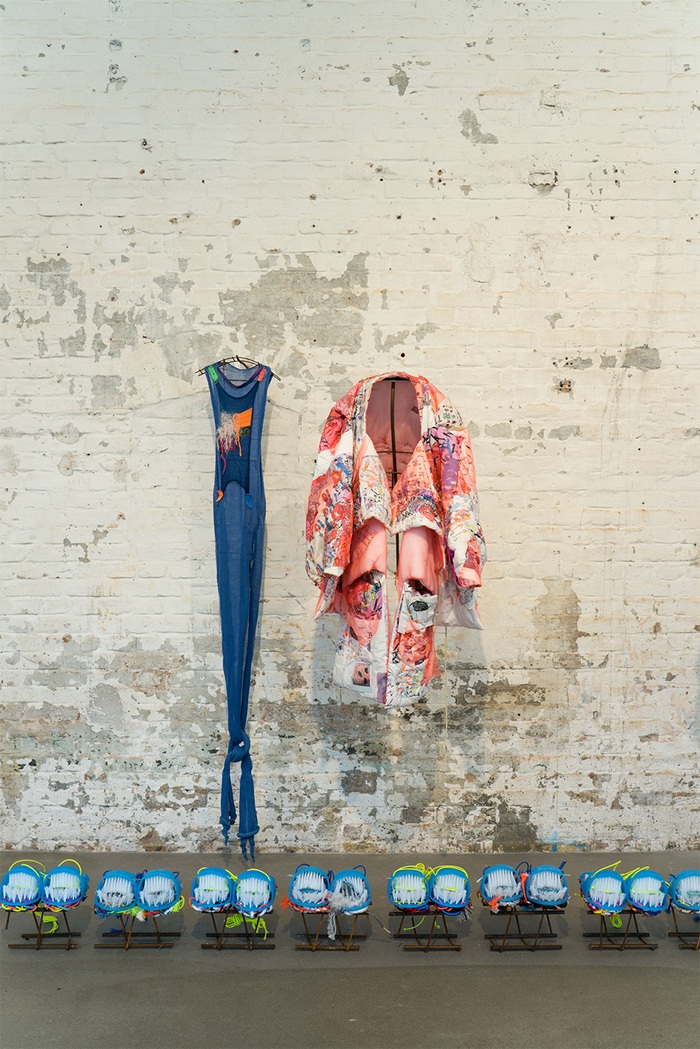Born 1988 in Naumburg an der Saale, formerly East Germany; lives and works in Berlin, Germany.
The perception of the things around us provides the starting point for Susi Hinz’s interdisciplinary work. In her practice, forms, images, words, and objects are collected and placed in relation to one another by the artist. Assembled together, these fragments of everyday life frame critical inquiries into our present time. With a keen sensitivity for entanglements and the possibilities of interweaving seemingly unrelated things, Hinz collages, confronts and superimposes natural and human-made objects into associative systems of thought, thus questioning topics such as desire, consumption, human consciousness and the urge for self-perception. In this process of confrontation, numerous stages follow one another: objects become sculptures, drawings evolve into conceptual statements, collages are translated into printed fabric which in turn is built into wearable pieces, sparking performances and a new conceptual framework. By letting this instinctive process run its course, Hinz’s practice quotes itself in numerous ways, building on past research and projects, while continuing to expand and reach out for new material and questions.
After vocational training as a seamstress and subsequent fashion studies at the weißensee kunsthochschule berlin (2007-11), Hinz has increasingly distanced herself from the world of commercial fashion, while expanding the media of her work in numerous ways. Two of the collections that she created during her university studies, Brilliant Housemates and HEADMACHINE, already bear witness to her perception of clothing as a means of communication: as wearable sculptures that interact with the body instead of merely covering it. Hinz integrated the latter collection into the performance HEADMACHINE: Ego im Gegenego in July of 2019. In addition to the wearable sculptures, which were presented by numerous performers inside the glass-covered greenhouses, she showed large-format drawings, a sound collage and her “system models”: sculptural works based on found materials, which the artist assembles according to an intuitive logic. Despite their different formats, all of these works are part of a shared aesthetic and thematic exploration.
Over the course of her residency at Callie’s, Hinz once again expanded her practice to another medium with her “room-book” project Das Armgehirn des Nochmensch, literally translated to “The Arm Brain of the Still-Human.” Hinz used the four chapters “Wall,” “Nuclear Fusion,” “Hikikomori” and “Hydra” as a structure to collage, superimpose and condense her visual material and poetry. Using the book format, she gave herself a formal outlet to revisit past subjects and interests while developing new lines of inquiry. This self-examination became the point of departure for the artist’s first solo exhibition, which opened at Callie’s in September of 2020.
In 2021, Hinz created masks for Rosa Barba’s performance Voice Engine, which had it’s world premiere at Callie’s in June of 2021.
Susi Hinz was born in 1988 in the Central German city of Naumburg an der Saale. After a vocational training as a dressmaker (2007-10), she completed a Bachelor of Arts in Fashion Design at the Weißensee Kunsthochschule Berlin in 2016. Her works have subsequently been shown in numerous group and solo presentations, for example at the exhibition festival unselect of the Kleine Humboldt Galerie, Gewächshäuser Dahlem (2019), Curatorial Part Uno, Alte Münze (2018) as well as Affen, Steine, Kühlerhauben, Kunstquartier Bethanien (2017). In 2017, Hinz showed with AktionV01 a seven-day interactive performance work in an advertising box, the Vitrine01, in the subway station Birkenstraße, Berlin-Moabit. In 2016, she received the Mart Stam Prize for graduates of the weißensee kunsthochschule berlin. Hinz lives and works in Berlin.







